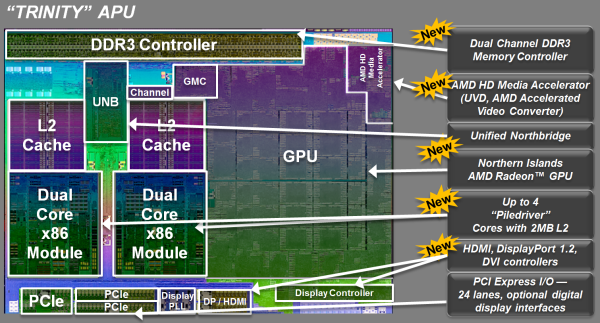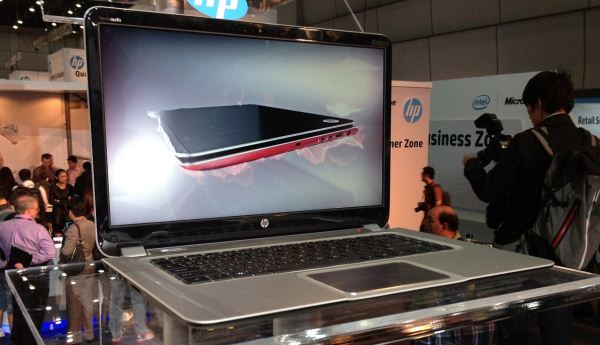The AMD Trinity Review (A10-4600M): A New Hope
by Jarred Walton on May 15, 2012 12:00 AM ESTConclusion: What Makes a Trinity?
I have often wondered about where AMD came up with the codename Trinity (other than the river name, of course). Was it a reference to this being AMD’s third APU? Or maybe AMD was gunning for the Holy Trinity of Performance, Battery Life, and Cost—get wins in all three areas and you’d have a guaranteed best seller! If that’s what AMD was hoping to accomplish, they’ve got a good foundation but we’ll need to see what the laptop OEMs come up with before issuing a final verdict.
To recap, Trinity is AMD’s continued journey down the path they started with Llano. Both CPU and GPU performance have improved over Llano. The general purpose CPU performance gap vs. Intel is somewhere in the 20—25% range, while the GPU advantage continues to be significantly in AMD's favor. It is surprising that Intel's HD 4000 is able to win even in some tests, but overall AMD continues to deliver better GPU performance even compared to Ivy Bridge. It's worth pointing out that the concerns about AMD's battery life from a few years ago are now clearly put to rest. At least at the TDPs we've tested, AMD is easily competitive with Intel on battery life.
AMD's GPU accelerated software lineup this time around is significantly better than it was with Llano, but we're still not quite where we need to be yet. I will hand it to AMD though, progress is clearly being made. Battery life is generally a step forward vs. Llano, which is more than we've been able to say about Ivy Bridge thus far.
The improvements in Piledriver really appear to have saved Trinity. What was a very difficult to recommend architecture in AMD's FX products has really been improved to the point where it's suitable for mobile work. AMD couldn't push performance as aggressively as it would have liked given that it's still on a 32nm process and the APU needs to make money. A move to 2x-nm could help tremendously. Similarly the move to a more efficient VLIW4 GPU architecture and additional tuning helped give AMD a boost in GPU performance without increasing die size. Overall, Trinity is a very well designed part given the process constraints AMD was faced with.
As a notebook platform, Trinity's CPU performance isn’t going to set any new records but it’s certainly fast enough for most users; battery life isn’t at the head of the class, but it’s better than just about anything that doesn’t qualify as an ultrabook; and finally there’s the question of cost. That last item isn’t really in AMD’s control, as the final cost of a laptop is a product of many design decisions, so let’s do some quick investigation into laptop pricing.
If you figure on memory, motherboard, chassis, LCD, and storage as all being the same, a typical laptop will have a starting price point of around $300—for a cheap, injection molded plastic shell, 4GB RAM, a 5400RPM HDD, a 1366x768 TN panel, and a no-frills feature set. Take that same basic platform and you can make an Intel laptop and have a BoM (Bill of Materials) cost of around $450, or you can make an AMD laptop and your BoM might start at $400. Depending on what other upgrades an OEM makes, as well as marketing, R&D, and profit, and we end up at a final price tag that might be $600 for a Trinity laptop compared to $700 for an Ivy Bridge laptop. The problem is that AMD doesn't just compete against vanilla Ivy Bridge; it has to compete against all the existing laptops as well.
Right now, Llano A8 laptops at Newegg have a starting price of $480 for an A8-3500M Acer Aspire, and they range up to $700 for a 17.3” HP dv7. The highest performance laptop of the bunch is probably Samsung’s Series 3, which uses an A8-3510MX APU and goes for $680. I suspect we’ll see similar pricing for Trinity laptops. On the Sandy Bridge Core i3/i5 side of the fence, Newegg has a much larger selection of laptops, starting at $430 for a Lenovo G570, $550 for the cheapest Core i5 model (again from Acer), and going up to $680 or more for laptops with Core i5 and NVIDIA Optimus graphics. Or if you prefer some place other than Newegg, you can find Core i5-2450M with GT 540M in Acer’s AS4830TG for $600.
That pretty much defines the maximum price we should expect people to pay for Trinity, as Core i5 with Optimus will deliver better CPU and GPU performance based on our test results. Obviously there are other factors to consider, like build quality of the laptop(s), display quality, battery life, and features, but most people shopping for an inexpensive laptop are going to be looking at cost first and features second. On the other hand, if you want style as a consideration, HP’s new sleekbooks will have Trinity versions starting at $600 for 15.6” and $700 for 14”—though it’s not clear which APU you’ll get at those prices. As long as last-generation Sandy Bridge laptops are at clearing house prices, though, AMD’s partners are going to need to be under $600 for something like the A10-4600M laptop we’re reviewing today. Assuming they can manage that, Trinity should see plenty of volume with the back to school season coming over the next few months.
For those who are interested in more than just the bottom line, as usual the best laptop for you may not be the best laptop for everyone. Trinity in a 14” form factor like our prototype would make for a great laptop to lug around campus for a few years. It would be fast enough for most tasks, small enough to not break your back, battery life would be long enough to last through a full day of classes, and the price would be low enough to not break your bank. And if mom and dad are footing the bill, you even get to disguise the fact that it’s a gaming capable laptop by not having a discrete GPU specifically called out on the features list. On the other hand, if you’re after a higher performance laptop or you want a “real” gaming system—something that can hand high detail settings at 1600x900 for instance—your best bet continues to be laptops with an Intel CPU and a discrete GPU from NVIDIA, at least of the GT 640M level—I’d say AMD GPUs as well, but I’m still waiting for a better switchable graphics solution.
At this point, AMD has done everything they can to provide a compelling mobile solution. The difficulty is that there's no longer a single laptop configuration that will be "best" for everyone, and Trinity only serves to further muddy the water. Intel continues to offer better CPU performance, and if you need graphics—which mostly means you want to play games—they have a good partner with NVIDIA. AMD on the other hand is delivering better integrated graphics performance with less CPU power, and depending on what you want to do that might be a more well rounded approach to mobile computing. What we need to see now are actual laptops and their prices. To trot out a tired old saying once more, "There are no bad products; only bad prices." Now it's up to AMD's partners to make sure Trinity laptops are priced appropriately.












271 Comments
View All Comments
medi01 - Thursday, May 17, 2012 - link
That's simply BS, my dear.Most of the "starting" task is HDD bottlenecked.
Having a lot of apps loaded is RAM constrained.
It has ABSOLUTELY NOTHING to do with CPU power.
B3an - Thursday, May 17, 2012 - link
Yeah because the CPU just does nothing, at all, ever. It just sits there totally idle all the time right.medi01 - Friday, May 18, 2012 - link
That's exactly what modern CPUs do (for quite a while) in a majority of PCs most of the times: IDLE. You didn't know that? Oh well. (Gamers being an exception)I encode video a lot (so far the most CPU extensive task besides gaming that you can imagine at home, which seems to be shifting towards GPU though) and even that is a "batch" task, I couldn't care less whether it is finished at 2pm or 3pm at night.
sviola - Tuesday, May 15, 2012 - link
Well, load eclipse or Visual Studio, a local DB server, a local application server, a few browser windows, some spreadsheets and documents, a couple of IM and some terminal windows and you got my usual work setup running. It can be demanding on the CPU and sometimes make the system slow down. And waiting for the system to respond can be frustrating in these situations, not mentioning having to compile all the project...mpschan - Tuesday, May 15, 2012 - link
Are you really expecting to do all that processing on a 500-700 dollar laptop? You're clearly doing work-related activities, which is not the target consumer here.Spunjji - Wednesday, May 16, 2012 - link
+100. Tired of this ass-hattery.mikato - Wednesday, May 16, 2012 - link
I think your biggest problems there would be Eclipse/Visual Studio. Also if you're using MS SQL Server as the DB (with Management Studio?) then definitely that too. And I don't know what app server you mean. Compiling projects? This stuff can be slow on a desktop, come on. How about using a lighter IDE or Notepad++ or MySQL for the DB.... or doing this work on a desktop like everyone else.medi01 - Thursday, May 17, 2012 - link
Mentioned example sickens me. I do similar stuff. Except I also have virtual machine running on top of things.NOT ENOUGH RAM is what you get in these situation, not slow CPU!!!!
CeriseCogburn - Thursday, May 24, 2012 - link
Well then all core 2 / duo users can just upgrade their ram no need for this trinity laptop crap.No buying anything but some cheap ram.
Glad to hear it.
xd_1771 - Tuesday, May 15, 2012 - link
BSMonitor, none of those tasks are CPU intensive and will consume less than 50% of that CPU.Your analogy is completely backwards. With programs INCLUDING video playback programs (seriously, I want you to name a popular video codec that isn't going to be accelerated by this GPU - this standard has existed for a number of years), office programs (Office 2010 and up) and pretty much every major web browser in existence having moved onto making large use of GPU acceleration, CPU will start ceasing to matter. The Trinity APU is very well balanced for the performance on both sides that it offers.
With more TRUE cores to balance non-intensive CPU workloads around than the competition, it arguably offers much better multitasking ability.